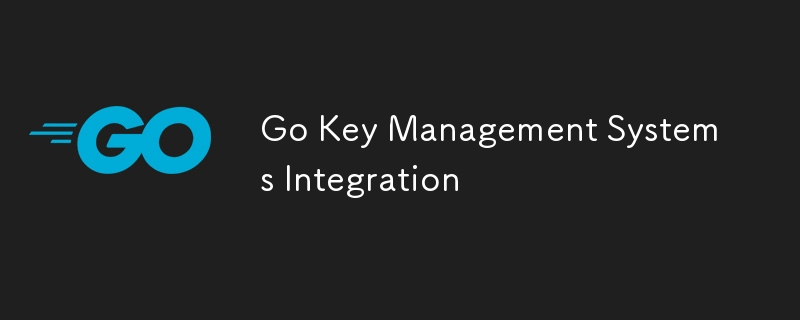Integrating the key management system in enterprise IT systems requires attention to protocol selection, permission control, context delivery and testing mechanisms. 1. Priority is given to the use of standard protocols such as KMIP or REST APIs to reduce development risks and refer to manufacturer cases; 2. Design a fine permission model, divide roles by service and use policy to control access; 3. Ensure that clear context information is passed every time KMS is requested to avoid hard coding and version misuse; 4. Simulate fault scenarios before going online and establish a monitoring system to ensure the stability and security of the system.

In enterprise IT systems, the integration of key management systems is a key security link. If handled improperly, serious safety hazards may be left; but if the method is appropriate, it can not only improve safety, but also improve operation and maintenance efficiency. Here we focus on several aspects that need to be paid attention to in actual operations.

Select a system that supports standard protocols
Many companies tend to ignore compatibility issues when integrating Key Management Systems (KMS). In fact, most modern KMSs support common standard protocols, such as KMIP (Key Management Interoperability Protocol) or REST API. If you are using cloud services, platforms such as AWS KMS and Azure Key Vault also provide SDKs and standard interfaces.
- Prioritize standard protocols : This reduces the risks posed by custom development.
- Check out the integration cases in the document : Manufacturers usually provide examples of docking with other systems, which can save a lot of time.
- Confirm whether automatic rotation is supported : Key rotation is an important part of security compliance, and manual operation is prone to errors.
Design permissions and access control well
The most easily underestimated during the integration process is the design of the permission model. A common mistake is to use the "Global Administrator" account to connect to KMS, which actually violates the principle of minimum permissions.

You should:
- Divide roles based on application or service
- Use policy-based access control (such as IAM Policy)
- Regularly audit the access log to see if there are any exception calls
For example, if you have multiple microservices that need access to the key, each service should have its own identity and can only access the keys it needs. In this way, even if a certain service is compromised, it will not affect the entire system.

Pay attention to the transmission of encryption context
This is a detail that many people ignore. When you get a key from a KMS, it is often more than just "take a key". Many times you need to pass in some additional information, such as encrypted data identifiers, purpose (encryption vs signing), tenant ID, etc.
- Make sure that each request has clear context information
- Avoid hard-coded context parameters
- Record context logic to facilitate subsequent maintenance
For example, some KMS systems will decide which version of the key to return based on the "Add Authentication Data" (AAD) you pass in. If you don't pay attention to this, it may result in decryption failure or misuse of old version keys.
Daily testing and failover mechanisms cannot be missing
Testing before going online often follows the process, but only when there is a real problem, it is discovered that there is not enough fault tolerance mechanism prepared. It is recommended that you simulate the following situations after the integration is completed:
- How the system reacts when a network is outage
- Behavior when the key does not exist or expires
- Is there a cache or standby option when the KMS service is unavailable
Also, don’t forget to include KMS’s health checks in your monitoring system. Once the response delay or the error rate is found, the problem can be checked in time.
Basically these are the key points. Integrating Go language projects and key management systems is not complicated, but there are indeed many details that are easily overlooked, especially in terms of permissions, protocols and context. As long as you plan clearly in advance, it will be much easier to maintain in the later stage.
The above is the detailed content of Go Key Management Systems Integration. For more information, please follow other related articles on the PHP Chinese website!

Hot AI Tools

Undress AI Tool
Undress images for free

Undresser.AI Undress
AI-powered app for creating realistic nude photos

AI Clothes Remover
Online AI tool for removing clothes from photos.

Clothoff.io
AI clothes remover

Video Face Swap
Swap faces in any video effortlessly with our completely free AI face swap tool!

Hot Article

Hot Tools

Notepad++7.3.1
Easy-to-use and free code editor

SublimeText3 Chinese version
Chinese version, very easy to use

Zend Studio 13.0.1
Powerful PHP integrated development environment

Dreamweaver CS6
Visual web development tools

SublimeText3 Mac version
God-level code editing software (SublimeText3)
 VSCode settings.json location
Aug 01, 2025 am 06:12 AM
VSCode settings.json location
Aug 01, 2025 am 06:12 AM
The settings.json file is located in the user-level or workspace-level path and is used to customize VSCode settings. 1. User-level path: Windows is C:\Users\\AppData\Roaming\Code\User\settings.json, macOS is /Users//Library/ApplicationSupport/Code/User/settings.json, Linux is /home//.config/Code/User/settings.json; 2. Workspace-level path: .vscode/settings in the project root directory
 How to handle transactions in Java with JDBC?
Aug 02, 2025 pm 12:29 PM
How to handle transactions in Java with JDBC?
Aug 02, 2025 pm 12:29 PM
To correctly handle JDBC transactions, you must first turn off the automatic commit mode, then perform multiple operations, and finally commit or rollback according to the results; 1. Call conn.setAutoCommit(false) to start the transaction; 2. Execute multiple SQL operations, such as INSERT and UPDATE; 3. Call conn.commit() if all operations are successful, and call conn.rollback() if an exception occurs to ensure data consistency; at the same time, try-with-resources should be used to manage resources, properly handle exceptions and close connections to avoid connection leakage; in addition, it is recommended to use connection pools and set save points to achieve partial rollback, and keep transactions as short as possible to improve performance.
 Mastering Dependency Injection in Java with Spring and Guice
Aug 01, 2025 am 05:53 AM
Mastering Dependency Injection in Java with Spring and Guice
Aug 01, 2025 am 05:53 AM
DependencyInjection(DI)isadesignpatternwhereobjectsreceivedependenciesexternally,promotingloosecouplingandeasiertestingthroughconstructor,setter,orfieldinjection.2.SpringFrameworkusesannotationslike@Component,@Service,and@AutowiredwithJava-basedconfi
 Python for Data Engineering ETL
Aug 02, 2025 am 08:48 AM
Python for Data Engineering ETL
Aug 02, 2025 am 08:48 AM
Python is an efficient tool to implement ETL processes. 1. Data extraction: Data can be extracted from databases, APIs, files and other sources through pandas, sqlalchemy, requests and other libraries; 2. Data conversion: Use pandas for cleaning, type conversion, association, aggregation and other operations to ensure data quality and optimize performance; 3. Data loading: Use pandas' to_sql method or cloud platform SDK to write data to the target system, pay attention to writing methods and batch processing; 4. Tool recommendations: Airflow, Dagster, Prefect are used for process scheduling and management, combining log alarms and virtual environments to improve stability and maintainability.
 Understanding the Java Virtual Machine (JVM) Internals
Aug 01, 2025 am 06:31 AM
Understanding the Java Virtual Machine (JVM) Internals
Aug 01, 2025 am 06:31 AM
TheJVMenablesJava’s"writeonce,runanywhere"capabilitybyexecutingbytecodethroughfourmaincomponents:1.TheClassLoaderSubsystemloads,links,andinitializes.classfilesusingbootstrap,extension,andapplicationclassloaders,ensuringsecureandlazyclassloa
 How to work with Calendar in Java?
Aug 02, 2025 am 02:38 AM
How to work with Calendar in Java?
Aug 02, 2025 am 02:38 AM
Use classes in the java.time package to replace the old Date and Calendar classes; 2. Get the current date and time through LocalDate, LocalDateTime and LocalTime; 3. Create a specific date and time using the of() method; 4. Use the plus/minus method to immutably increase and decrease the time; 5. Use ZonedDateTime and ZoneId to process the time zone; 6. Format and parse date strings through DateTimeFormatter; 7. Use Instant to be compatible with the old date types when necessary; date processing in modern Java should give priority to using java.timeAPI, which provides clear, immutable and linear
 Google Chrome cannot open local files
Aug 01, 2025 am 05:24 AM
Google Chrome cannot open local files
Aug 01, 2025 am 05:24 AM
ChromecanopenlocalfileslikeHTMLandPDFsbyusing"Openfile"ordraggingthemintothebrowser;ensuretheaddressstartswithfile:///;2.SecurityrestrictionsblockAJAX,localStorage,andcross-folderaccessonfile://;usealocalserverlikepython-mhttp.server8000tor
 Using PHP for Data Scraping and Web Automation
Aug 01, 2025 am 07:45 AM
Using PHP for Data Scraping and Web Automation
Aug 01, 2025 am 07:45 AM
UseGuzzleforrobustHTTPrequestswithheadersandtimeouts.2.ParseHTMLefficientlywithSymfonyDomCrawlerusingCSSselectors.3.HandleJavaScript-heavysitesbyintegratingPuppeteerviaPHPexec()torenderpages.4.Respectrobots.txt,adddelays,rotateuseragents,anduseproxie






